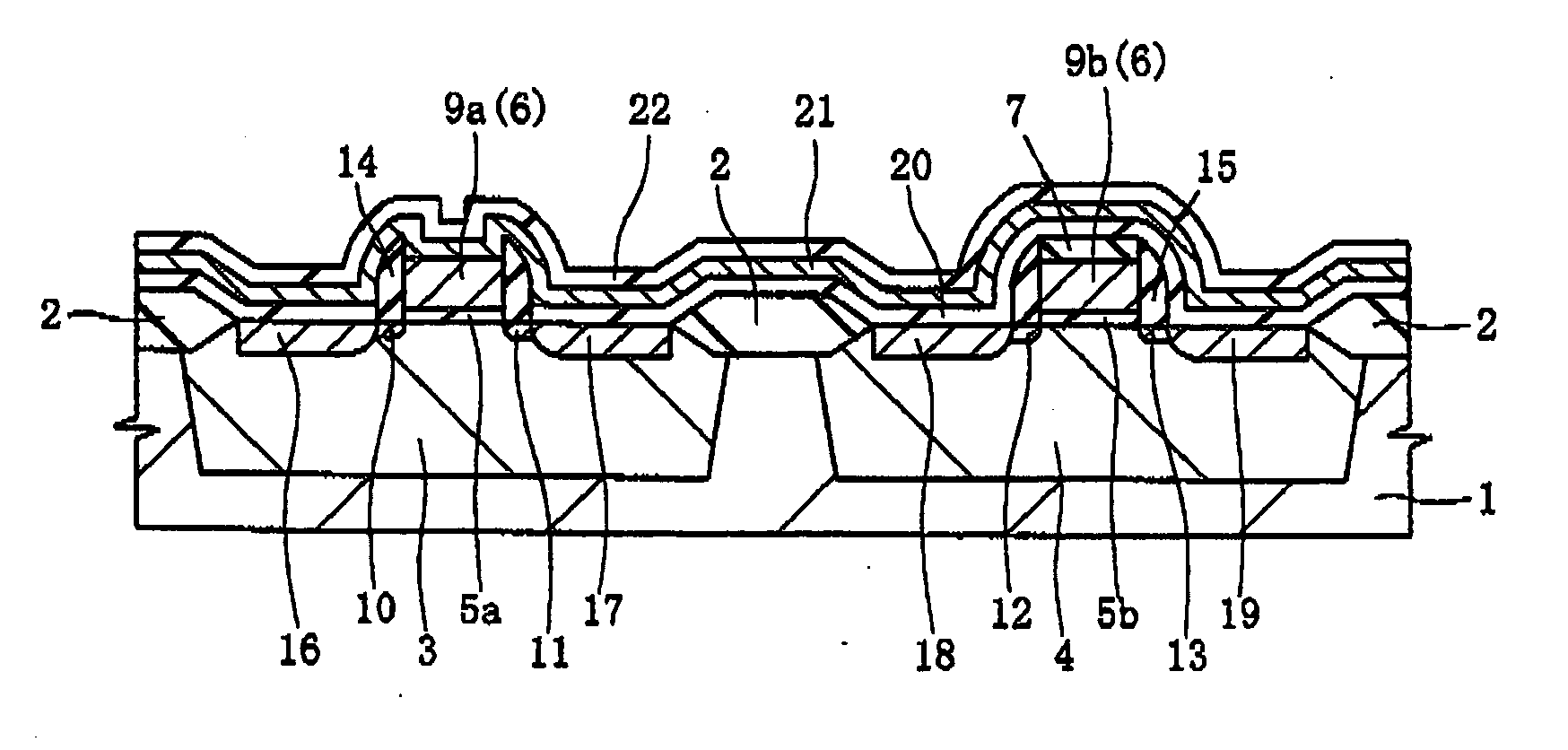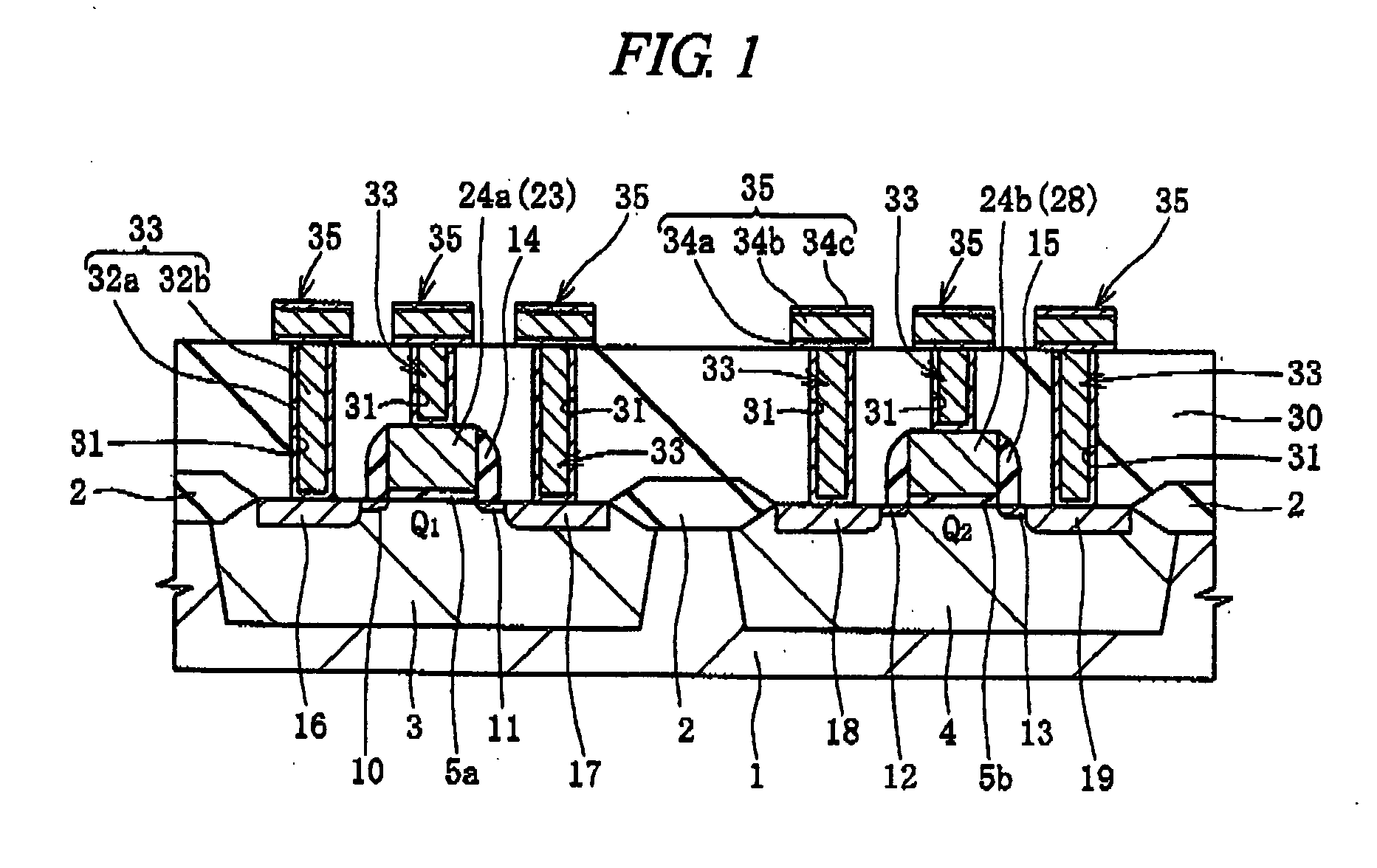Semiconductor device and manufacturing method thereof
a technology of semiconductor devices and manufacturing methods, applied in semiconductor devices, electrical devices, transistors, etc., can solve the problems of large parasitic capacity generated in the gate electrode by the depletion of the gate electrode, and the thickness of the gate insulating film has become smaller
- Summary
- Abstract
- Description
- Claims
- Application Information
AI Technical Summary
Problems solved by technology
Method used
Image
Examples
first embodiment
(First Embodiment)
[0043]FIG. 1 is a cross-sectional view showing an n-channel MIS transistor Q1 (referred to as an n-type MIS transistor Q1 hereinafter) and a p-channel MIS transistor Q2 (referred to as a p-type MIS transistor Q2 hereinafter) according to a first embodiment. In FIG. 1, element isolation regions 2 for isolating elements are formed on a semiconductor substrate 1, and a p-type well 3 and an n-type well 4 are formed in active regions isolated by the element isolation regions 2.
[0044] The n-type MIS transistor Q1 is formed on the p-type well 3, and the p-type MIS transistor Q2 is formed on the n-type well 4.
[0045] The n-type MIS transistor Q1 has a gate insulating film (first gate insulating film) 5a composed of, for example, a silicon oxide film and a gate electrode (first gate electrode) 24a on the gate insulating film 5a. The gate electrode 24a is formed of, for example, a hafnium silicide film 23. Since the value of work function of the hafnium silicide film 23 is ...
second embodiment
(Second Embodiment)
[0088] In the first embodiment, the case where a metal silicide film is used as a gate electrode has been described. Meanwhile, in the description of the second embodiment, a film of the same type as that of a metal silicide film constituting a gate electrode is formed on a source region and a drain region.
[0089]FIG. 14 is a cross-sectional view showing an n-type MIS transistor Q3 and a p-type MIS transistor Q4 according to the second embodiment. In FIG. 14, since the configuration of the n-type MIS transistor Q3 and the p-type MIS transistor Q4 is almost the same as that of the n-type MIS transistor Q1 and the p-type MIS transistor Q2 according to the first embodiment, only the different parts will be described below.
[0090] The n-type MIS transistor Q3 according to the second embodiment is different from the n-type MIS transistor Q1 according to the first embodiment in that hafnium silicide films 36 and 37 are formed on high-concentration n-type impurity diffus...
third embodiment
(Third Embodiment)
[0106] In the description of the second embodiment, the same metal silicide films as metal silicide films constituting gate electrodes are formed on the source region and the drain region in the n-type MIS transistor and the p-type MIS transistor. Meanwhile, in the third embodiment, the case where metal silicide films formed on a source region and a drain region of an n-type MIS transistor are formed of the same films as metal silicide films formed on a source region and a drain region of a p-type MIS transistor will be described.
[0107]FIG. 21 is a cross-sectional view showing an n-type MIS transistor Q5 and a p-type MIS transistor Q6 according to the third embodiment. In FIG. 21, since the configuration of the n-type MIS transistor Q5 is almost the same as that of the n-type MIS transistor Q3 according to the second embodiment, only the different parts will be described below.
[0108] The n-type MIS transistor Q5 according to the third embodiment is different from...
PUM
 Login to View More
Login to View More Abstract
Description
Claims
Application Information
 Login to View More
Login to View More - R&D
- Intellectual Property
- Life Sciences
- Materials
- Tech Scout
- Unparalleled Data Quality
- Higher Quality Content
- 60% Fewer Hallucinations
Browse by: Latest US Patents, China's latest patents, Technical Efficacy Thesaurus, Application Domain, Technology Topic, Popular Technical Reports.
© 2025 PatSnap. All rights reserved.Legal|Privacy policy|Modern Slavery Act Transparency Statement|Sitemap|About US| Contact US: help@patsnap.com



